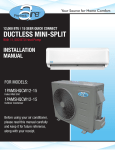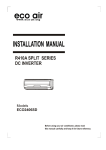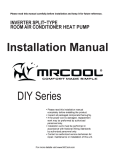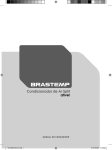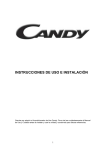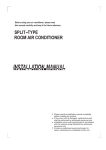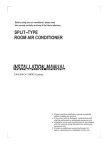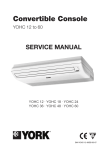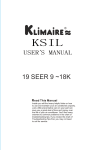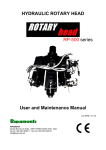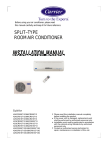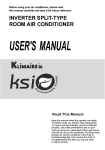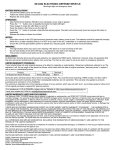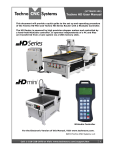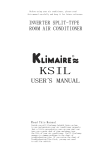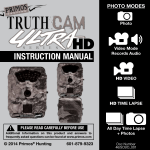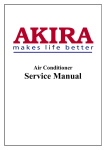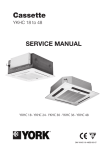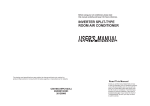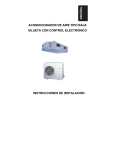Download KSID installation manual
Transcript
Before using your air conditioner, please read this manual carefully and keep it for future reference. INVERTER SPLIT TYPE ROOM AIR CONDITIONER SERIES Please read this installation manual completely before installing the product. If the power cord is damaged, replacement work shall be performed by authorised personnel only. Installation work must be performed in accordance with the national wiring Standards by authorised personnel only. Contact an authorised service technician for repair, maintenance or installation of this unit. CONTENTS SAFETY PRECAUTIONS Warning .....................................................................................................................................2 Caution ......................................................................................................................................2 INSTALLATION INSTRUCTIONS Selecting installation place.........................................................................................................3 Accessories ........ .....................................................................................................................4 Indoor unit installation................................................................................................................8 Outdoor unit installation.............................................................................................................9 REFRIGERANT PIPE CONNECTION Refrigerant pipe connection ......................................................................................................10 ELECTRICAL WORK Electrical work .................. .......................................................................................................12 TEST RUNNING Test running ...................... .....................................................................................................14 CAUTION Contact an authorised service technician for repair or maintenance of this unit. Contact the authinstaller for installation of this unit. This appliance is not intended for use by persons(including children) with reduced physical, sensory or mental capabilities, or lack of experience and knowledge, unless they have been given supervision or instruction concerning use of the appliance by a person responsible for their safety. Young children should be supervised to ensure that they do not play with the air conditioner. If the power cord is to be replaced, replacement work shall be performed by authorised personnel only. Installation work must be performed in accordance with the national wiring standards by authorised personnel only. 1 SAFETY PRECAUTIONS Read the follow SAFETY PRECAUTIONS carefully before installation. Installation must be performed in accordance with the requirement of NEC and CEC by authorized personnel only. Incorrect installation due to ignoring of the instruction will cause harm or damage, and the seri ousness is classified by the following indications. WARNING This symbol indicates the possibility of death or serious injury. CAUTION This symbol indicates the possibility of injury or damage to property. The items to be followed are classified by the symbols: Symbol will background white denotes item that is PROHIBITED from doing. WARNING 1) Engage dealer or specialist for installation. If installation done by the user is defective, it will cause water leakage, electrical shock or fire. 2) Install according to this installation instructions strictly. If installation is defective, it will cause water leakage, electrical shock or fire. 3) Use the attached accessories parts and specified parts for installation. otherwise, it will cause the set to fall, water leakage, electrical shock or fire. 4) Install at a strong and firm location which is able to withstand the set ,s weight. If the strength is not enough or installation is not properly done, the set will drop and cause injury. 5) For electrical work, follow the local national wiring standard, regulation and this installation instructions. An independent circuit and single outlet must be used. If electrical circuit capacity is not enough or defect found in electrical work, it will cause electrical shock or fire. 6) Use the specified cable and connect tightly and clamp the cable so that no external force will be acted on the terminal. If connection or fixing is not perfect, it will cause heat-up or fire at the connection. 7) Wiring routing must be properly arranged so that control board cover is fixed properly. If control board cover is not fixed perfectly, it will cause heat-up at connection point of terminal, fire or electrical shock. 8) When carrying out piping connection, take care not to let air substances other than the specified refrigerant go into refrigeration cycle. Otherwise, it will cause lower capacity, abnormal high pressure in the refrigeration cycle, explosion and injury. 9) Do not modify the length of the power supply cord or use of extension cord, and do not share the single outlet with other electrical appliances. Otherwise, it will cause fire or electrical shock. CAUTION 1) This equipment must be earthed and installed with earth leakage current breaker. It may cause electrical shock if grounding is not perfect. 2) Do not install the unit at place where leakage of flammable gas may occur. In case gas leaks and accumulates at surrounding of the unit, it may cause fire. 3) Carry out drainage piping as mentioned in installation instructions. If drainage is not perfect, water may enter the room and damage the furniture. 2 INSTALLATION INSTRUCTIONS More than 15cm/5.9in (to the ceiling) Selecting installation place Read completely, then follow step by step. More than More than Indoor unit 12cm/4.72in 12cm/4.72in Do not expose the indoor unit to heat or steam. Select a place where there are no obstacles in front or around the unit. Make sure that condensation drainage can be conveniently routed away. More than 2.3m/7.55ft Do not install near a doorway. (from the floor) Ensure that the space on the left and right Fig.1 of the unit is more than 12cm/4.72in. Use a stud finder to locate studs to prevent unnecessary damage to the wall. The indoor unit should be installed on the wall at a height of 2.3m/7.55ft or more from the floor. The indoor unit should be installed allowing a minimum clearance of 15cm/5.9in from the ceiling. Any variations in pipe length will/may require adjustment to refrigerant charge. There should not be any direct sunlight. Otherwise, the sun will fade the plastic cabinet and affect its appearance. If unavoidable, sunlight prevention should be taken into consideration. More than30cm/11.81in Outdoor unit More than 30cm/11.81in If an awning is built over the outdoor unit to prevent direct sunlight or rain exposure, make sure that heat radiation from the condenser is not restricted. More than Ensure that the clearance around the back 60cm/23.62in of the unit is more than 30cm/11.81in and left side is more than 30cm/11.81in. The front of the More than 200cm/78.74in unit should have more than 200cm/78.74in of clearance and the connection side (right side) Fig.2 should have more than 60cm/23.62in of clearance. Do not place animals and plants in the path of the air inlet or outlet. Take the air conditioner weight into account and select a place where noise and vibration will not be an issue. Select a place so that the warm air and noise from the air conditioner do not disturb neighbors. Rooftop installation: If the outdoor unit is installed on a roof structure, be sure to level the unit. Ensure the roof structure and anchoring method are adequate for the unit location. Consult local codes regarding rooftop mounting. If the outdoor unit is installed on roof structures or external walls, this may result in excessive noise and vibration, and may also be classed as a non serviceable installation. Tools needed for installation: Level gauge Screwdriver Electric drill,Hole core drill (φ90mm/3.54in) Flaring tool set Specified torque wrenches: 1.8kgf.m, 4.2kgf.m, 5.5kgf.m, 6.6kgf.m (different depending on model No.) Spanner (half union) 3 Hexagonal wrench (4mm/0.157in) Gas-leak detector Vacuum pump Gauge manifold Users manual Thermometer Multimeter Pipe cutter Measuring tape INSTALLATION INSTRUCTIONS Accessories Q’ty 1 Name of Accessories Installation Plate 2 Clip Anchor 5-8(depending on models) 3 Self-tapping Screw A ST3.9X25 5-8(depending on models) 4 Seal (For cooling & heating models only) 1 5 Drain Joint (For cooling & heating models only) 1 6 Remote controller 1 7 Self-tapping Screw B ST2.9X10 8 Remote controller holder 9 Quick connecting refrigerant pipe Number 1 2 Optional parts 1 1 10 Air freshening filter(used to install on Air filter) 11 Sound deadening pads(used to wrap up the quick connectors) 1(depending on models) 2 Note: Except the above parts provided, the other parts needed during installation you must purchase. 3 2 >15cm/5.9 in >12 cm CAUTION 1 Use a stud finder to locate studs to prevent unnecessary damage to the wall. Two of the A, B and C directions should be free from obstructions. This illustration is for explanation purposes only. Copper lines must be insulated independently. /4.7 2in >12cm/4.72in ilter A Air Outlet 30c m abo ve 60cm above >2.3m/7.54ft Air F B abo e bov ma 30c 60c ve cm 200 Quick connecting refrigerant pipe Remote Controller ma bov Mounting screw B ST2.9x10-C-H e C 6 8 ON/OFF SHORT CUT MODE 7 TIMER ON TEMP FAN TIMER OFF SLEEP SWING DIRECT TURBO LED Remote controller holder Fig.3 4 INSTALLATION INSTRUCTIONS Correct orientation of Installation Plate Indoor unit installation 1. Fit the Installation Plate 1. F i t t h e i n s t a l l a t i o n p l ate horizontally o n s t r u c t u r a l p a r t s o f the wall with s p a c e s a r o u n d t h e i n s t allation plate. 2. I f t h e w a l l i s m a d e o f b rick, concrete or t h e l i k e , d r i l l f i v e o r eight 5mm/0.197in d i a m e t e r h o l e s i n t h e wall. Insert Clip a n c h o r f o r a p p r o p r i a t e mounting screws. 3. F i t t h e i n s t a l l a t i o n p l ate on the wall with e i g h t o r f i v e t y p e A s crews. Fig.4 150mm/5.91in or more to ceiling C 120mm/4.72in or more to wall 55/ 2.1 7 B 41 55/ 2.1 7 120mm/4.72in or more to wall Left rear side refrigerant pipe hole φ90/3.54in Note: Fit the Installation Plate and drill holes in the wall according to the wall structure and corresponding mounting points on the installation plate. Indoor unit outline D Right rear side refrigerant pipe hole φ90/3.54in A 9000Btu/h models(A:680/26.77, B:255/10.04, C:170/6.69, D:92/3.62) 12000Btu/h models(A:770/30.31, B:255/10.04, C:170/6.69, D:95/3.74) 150mm/5.91in or more to ceiling 36.5 55/ 2.1 7 Left rear side refrigerant pipe hole φ90/3.54in B 120mm/4.72in or more to wall 120mm/4.72in or more to wall 55/ 2.1 7 (Dim e n s i o n s a r e i n m m / i n u nless othe r w i s e s t a t e d ) Indoor unit outline D C A Right rear side refrigerant pipe hole φ90/3.54 18000Btu/h models(A:905/35.63, B:275/10.83, C:80/3.15, D:100/3.94) 150mm/5.91in or more to ceiling 293/11.54 Installation plate 163/6.42 120mm/4.72in or more to wall 21.5/0.85 55 Left rear side refrigerant pipe hole φ90/3.54in 315/12.4 Indoor unit outline 1030/40.55 120mm/4.72in or more to wall Right rear side refrigerant pipe hole φ90/3.54 22000Btu/h models 150mm/5.91in or more to ceiling 120mm/4.72in or more to wall 55/2.17 Left rear side refrigerant pipe hole φ90/3.54in 35/1.38 >30000Btu/h models Fig.5 5 340/13.39 25/0 .98 1450/57.09 INSTALLATION INSTRUCTIONS Wall 2. Drill a hole in the wall Outdoor Indoor 5-7mm /0.2-0.28in 1. Determine hole positions according to the diagram detailed in Fig.5. Drill one (1) hole (φ90mm/3.54in) slanting slightly to outdoor side. 2. Always use wall hole conduit when drilling metal grid, metal plate or the like. Fig.6 3. Drainage Installation Drainage 1. Run the drain hose sloping downward. Do not install the drain hose as illustrated in Fig.7. 2. When connecting extension drain hose, insulate the connecting part of extension drain hose with a shield pipe, do not let the drain hose slack. 4. Connecting the refrigerant pipes 4.1 Tools needed -You will require the following tools to carry out this installation work correctly: 1x open-ended spanner, 19 mm/0.75in 1x open-ended spanner, 22 mm/0.87in 1x open-ended spanner, 24 mm/0.95in 1x Allen key, 5 mm/0.2in 1x Philips screwdriver 1x leak detection spray or alternatively soap suds (water/detergent mix) 4.2 Important information Follow the detailed instructions for connecting the refrigerant pipes to the indoor unit and outdoor unit. We can only provide a warranty if the lines are installed correctly as described in the instructions. Do not remove the sealing caps and stoppers until immediately before you install the lines. To prevent leaks, ensure that the quick-release screw connections are absolutely free of dirt. Moisture or foreign bodies will adversely affect the function of the quick-release connectors, leading to a risk of refrigerant loss (not covered by the warranty). Only install refrigerant lines outdoors in dry weather. The refrigerant lines must not be installed and then plastered over. Please make sure that refrigerant is never allowed to enter the environment. Improper handling of refrigerant may be harmful to health. Always wear work gloves and goggles when handling refrigerant. 6 Do not put the hose end into water or any container Do not form a rise Fig.7 Refrigerant pipe Connectors(both ends): Fig.8 NOTE: To distinguish the connectors to be connected to the indoor unit and outdoor unit, the connectors of the refrigerant pipe has been labelled “A”, “B”,“C”and “D”. Ensure the marks on the connectors are the same to the indoor s and outdoor s respectively during connection. , , INSTALLATION INSTRUCTIONS Do not smoke during the installation work. The equipment must never be operated without the refrigerant lines connected, otherwise the equipment will be damaged immediately. The screw connections may only be tightened using the appropriate open-ended spanner. Remember that if they are tightened with too little torque they will leak but if they are tightened with too much torque, the screw connections may suffer damage. If you should not be confident about connecting the refrigerant line connectors yourself, it is imperative that you contact your customer service team or a refrigeration contractor. Important! The EQ valves are only designed for one-time installation. Their seal can not be guaranteed if they are installed on more than one occasion. This will also void the warranty. 4.3 Connecting the refrigerant pipes to indoor unit 1. Do not remove the plastic seals from the indoor equiopment and the appropriate refrigerant pipe until immediately before you connect them. 2. Align the refrigerant pipes correctly, make sure the dimensions of the connecting refrigerant pipe are the same. Place the screw connector on the refrigerant pipes just on to the thread on the indoor equipment and tighten the first few threads by hand. See Fig.9. IMPORTANT: Before you continue, it is essential that you read the following instructions carefully. Fig.9 A B Fig.10a Fig.10b ,, ,, 3. Hold the points marked A using a 22mm/0.87in openended spanner and turn the nuts only at the points ,, ,, marked B using a 24mm/0.95in open-ended spanner. See Fig.10a & 10b. 4. Ensure that the screw connectors do not skew as you tighten them and work quickly. IMPORTANT: Since the coupling works with tapping rings, it may leak if you undo and reconnect the pipes. This will also void the warranty. Fig.11 5. After finishing the connection, first wrap up the quick connectors with the sound deadening pads(packed with accessories) solidly and tightly as shown in Fig.11, then use the tape to wrap the refrigerant pipe and connecting cable together. See Fig.12. NOTE: For aesthetic reason, the quick connector parts are recommended to be placed outside of room. Fig.12 7 INSTALLATION INSTRUCTIONS Note: Route the package of pipes/hoses in the direction of (rear)right or (rear)left. See Fig.13 . 1.Both sides drainage structure is standard. For both sides drainage structure, it can be choosen for right, left or both sides drainage connection. If choosing both sides drainage connection, another proper drain hose is needed as there is only one drain hose offered by factory. If choosing one side drainage connection, make sure the drain hole on the other side is well plugged. For 9k/12k models, if choosing left-hand or left-back piping,please choosing left side drainage connection. The connection of the drain hose is supposed to be done by qualified installer in case of water leakage. 2. Bundle the tubing, connecting cable with tape securely, evenly as shown in Fig.14. Because the condensed water from rear of the indoor unit is gathered in ponding box and is piped out of room. Do not put anything else in the box. Rubber plug CAUTION: Do not allow the piping to let out from the back of the indoor unit. Be careful not to let the drain hose slack. Heat insulated both of the auxiliary piping. Be sure that the drain hose is located at the lowest side of the bundle. Locating at the upper side can cause drain pan to overflow inside the unit. Never intercross nor intertwist the power wire with any other wiring. Run the drain hose sloped downward to drain out the condensed water smoothly. 5. Indoor unit installation 1. Feed the package of pipes/hoses through the hole in the wall. 2. Hook the indoor unit onto the upper portion of the installation plate.(Engage the two hooks of the rear top of the indoor unit with the upper edge of the installation plate.) Ensure that the hooks are properly seated on the installation plate by moving it left and right. 3. The female half can easily be made by lifting the indoor unit with a cushioning material between the indoor unit and the wall. Get it out after finish piping. 4. Press the lower left and right sides of the unit against the installation plate until the hooks engage into their slots. 8 Fig.13 Indoor unit Ponding box Connective cable Pipe room ...... . .. ...... .. .. . ........ . . . Drain hose Fig.14 Fig.15 Connective pipe Wrapping belt INSTALLATION INSTRUCTIONS Outdoor unit installation Outdoor unit 1. Outdoor installation precaution Select the location for installation(follow the previous notes on selecting the installation place). If the outdoor unit is higher thanthe indoor unit, make sure that a curve is made in the refrigerant pipe which is lower than the bottom edge of the indoor unit. See Fig.16. In the case that the installation place is exposed to strong wind such as a seaside, make sure the fan operating properly by putting the unit lengthwise along the wall or using a dust or shield plates, Fig.17. If need suspending installation, the installation bracket should accord with technique requirement in the installation bracket diagram. The installation wall should be solid brick, concrete or the same intensity construction, or actions to reinforce, damping supporting should be taken. The connection between bracket and wall, bracket and the air conditioner should be firm, stable and reliable. Be sure there is no obstacle which block radiating air. Refrigerant pipe Indoor unit Curve Fig.16 Strong wind Fig.17 2. Settlement of outdoor unit Anchor the outdoor unit with a bolt and nutφ10 or φ8 tightly and horizontally on a concrete or rigid mount. Outdoor unit dimension mm/in(WxHxD) Mounting dimensions A(mm/in) B(mm/in) 760(29.92)x590(23.23)x285(11.22) 530(20.87) 290(11.42) A 820(32.28)x595(23.43)x330(12.99) 523(20.59) 340(13.39) Air inlet 780(30.71)x540(21.26)x250(9.84) 549(21.61) 276(10.87) 660(25.98)x242(9.52)x540(21.26) 458(18.03) 276(10.87) 840(33.07)x700(27.56)x320(12.6) 560(22.05) 335(13.19) 990(38.98)x965(37.99)x345(13.58) 624(24.57) 366(14.41) W D B Air inlet Air outlet Fig.18 Drain joint installation NOTE: The drain joint is slightly different according to the different outdoor unit. For the drain joint with the seal(Fig.19 (A)), first fit the seal onto the drain joint, then insert the drain joint 。 into the base pan hole of outdoor unit, rotate 90 to securely assemble them. To install drain joint as shown in Fig.19 (B), insert the drain joint into the base pan hole of outdoor unit until it remains fixed with a clicking sound. Connecting the drain joint with an extension drain hose (Locally purchased), in case of the water draining off the outdoor unit during the heating mode. 9 Seal Drain joint Base pan hole of outdoor unit (B) Seal Drain pipe (A) Fig.19 REFRIGERANT PIPE CONNECTION 4. Connecting the refrigerant pipe to outdoor unit CAUTION: For your safety, always wear goggles and work gloves when connecting the pipes. NOTE: To distinguish the connectors to be connected to the indoor unit and outdoor unit, the connectors of the refrigerant pipe has been labelled “A”, “B”,“C”and “D”. Ensure the marks on the , , connector are the same to the indoor s and outdoor s respectively during connection. 1. First remove the water tray on the outdoor unit as shown in Fig.20. 2. Do not remove the plastic seals from the outdoor unit and the appropriate refrigerant pipes until immediately before you connect them, Fig.21. 3. Align the refrigerant pipes correctly so that they line up with the valves and are not stressed. Place the screw connector on the refrigerant line just on to the thread on the outdoor unit and tighten the first few threads by hand, Fig.22. NOTE: The refrigerant pipes must be connected to the valves on the outdoor unit with as little stress as possible. IMPORTANT: Before you continue, it is essential that you read the following instructions carefully. 4. Now tighten the bottom screw connector first and then the top screw connector using the open-ended spanner. Hold the points marked “A”using a 22mm/0.87in open-ended spanner and turn the nuts only at the points marked “B” using a 24mm/0.95in open-ended spanner, see Fig.23. Ensure that the screw connectors do not skew as you tighten them and work quickly. See the next page for the proper torque. Fig.20 Fig.21 Fig.22 IMPORTANT: Since the coupling works with tapping rings, it may leak if you undo and reconnect the pipes. This will also void the warranty. A B B A Fig.23 10 REFRIGERANT PIPE CONNECTION Coupling size (last 2 part numbers) Pound-force foot(1bf-ft) Newton meter(N-m) Kilogram-force meter(kgf-m) -06(9.5mm/3/8 dash size) 18 - 20 24.4 - 27.1 2.4 - 2.7 -08(12.7mm/1/2 dash size) 30 - 35 40.6 - 47.4 4.1 - 4.8 -12(19.1mm/3/8 dash size) 45 - 50 61.0 - 67.7 6.2 - 6.9 -16(25.4mm/1 dash size) 60 - 65 81.3 - 88.1 8.2 - 8.9 After completing steps 1- 4, check that all the connections are sealed correctly using leak detection spray or soap suds. If any bubbles form, the system has a leak and the screw connectors must be retightened using an open-ended spanner. 5. Now remove the cover on the top valve using a 19 mm open-ended spanner. Open the valve by turning it counter-clockwise as far as it will go using a 5 mm Allen key. The valve is now open. If the valve is not opened fully, the system may malfunction and suffer damage. Screw the cover back on to the top valve and tighten it well to ensure that it is properly sealed. See Fig.24. 6. Now remove the cover on the bottom valve using a 19 mm open-ended spanner. Open the valve by turning it counter-clockwise as far as it will go using a 5 mm Allen key. The valve is now open. If the valve is not opened fully, the system may malfunction and suffer damage. Screw the cover back on to the bottom valve and tighten it well to ensure that it is properly sealed. See Fig.25. Fig.24 Important! The conical ring on the valve has an important sealing function together with the sealing seat in the caps. Ensure that you do not damage the cone and that you keep the cap free of dirt and dust. 7. After completing steps 1- 6, check that all the connections are sealed correctly using leak detection spray or soap suds. If any bubbles form, the system has a leak and the screw connectors must be retightened using an open- ended spanner. 8. Start the equipment so that the operating pressures build up inside it. Check all the connectors again for signs of leaks a) during cooling mode b) in heating mode. If any bubbles form, the system has a leak and the screw connectors must be retightened using an open-ended spanner. Fig.25 11 ELECTRICAL WORK CAUTION CAUTION CAUTION CAUTION After the confirmation of the above conditions, prepare the wiring as follows: 1) Never fail to have an individual power circuit specifically for the air conditioner. As for the method of wiring, be guided by the circuit diagram posted on the inside of control cover. 2) The screw which fasten the wiring in the casing of electrical fittings are liable to come loose from vibrations to which the unit is subjected during the course of transportation. Check them and make sure that they are all tightly fastened. (If they are loose, it could cause burn-out of the wires.) 3) Specification of power source. 4) Confirm that electrical capacity is sufficient. 5) See to that the starting voltage is maintained at more than 90 percent of the rated voltage marked on the name plate. 6) Confirm that the cable thickness is as specified in the power source specification. 7) Always install an earth leakage circuit breaker in a wet or moist area. 8) The following would be caused by voltage drop. Vibration of a magnetic switch, which will damage the contact point, fuse breaking, disturbance of the normal function of the overload. Electrical work Electric safety regulations for the initial Installation 1. If there is serious safety problem about the power supply, the technicians should refuse to install the air conditioner and explain to the client until the problem is solved. 2. Power voltage should be in the range of 90%~110%of rated voltage. 3. The surge protector and main power switch with a 1.5 times capacity of Max. Current of the unit should be installed in power circuit. Ensure the air conditioner is grounded well. 4. The appliance shall be installed in accordance with national wiring regulations. Do not operate your air conditioner in a wet room such as a bathroom or laundry room. 5. An all-pole disconnection device which has at least 3mm clearances in all poles, and have a leakage current that may exceed 10mA, the residual current device(RCD) having a rated residual operating current not exceeding 30mA, and disconnection must be incorporated in the fixed wiring in accordance with the wiring rules. 6. For the unit adopts auxiliary electric heater, keep at least 1 meter away from the nearest combustible materials. 7. According to the attached Electrical Connection Diagram located on the panel of the indoor & outdoor unit to connect the wire. All wiring must comply with local and national electrical codes and be installed by qualified and skilled electricians. 8. An individual branch circuit and single receptacle used only for this air conditioner must be available. See the following table for suggested wire sizes and fuse specifications: Suggest Minimum Wire Size (AWG:American Wire Gage): Appliance Amps NOTE: AWG Wire Size 10 18 13 16 18 14 25 12 30 10 40 8 The wire size of power supply cord and interconnected wire and the current of the fuse or switch are determined by the maximum current indicated on the nameplate which located on the side panel of the unit. Please refer to the nameplate before selecting the wire size, fuse or switch. The controller of the air conditioner designed with a fuse protection function under abnormal conditions, the specifications of the fuse have printed on the circuit board, such as: T3.15A/250VAC, T5A/250VAC, etc. 12 ELECTRICAL WORK Front Panel Connect the cable between indoor unit and outdoor unit Electronic box cover NOTE: Before performing any electrical work, turn off the main power to the system. 1. The connection cables of indoor and outdoor units have been connected to the terminals on the control board except the grounding wire(Y/G), only white plug connectors exposed. See Fig.27. 2. Remove the control cover from the outdoor unit by loosening the screw. 3. Hold the indoor male plug and insert it into the female plug of the outdoor unit until it fixed with a clicking sound. Secure the cable onto the control board with the cord clamp. See Fig.27. 4. Connect the grounding wire to the terminal on the control board individually. 5. The electrical connection has finished now. Fig.26 Terminal block of indoor unit L N L N S or S L1 L2 L2 L1 S S Cord clamp G G Cover To outdoor unit Screw To outdoor unit 208-230V~60Hz 115V~60Hz Terminal block of outdoor unit 1(L) 2(N) S L L1 L2 N G G To power supply S L1 L2 G G To power supply To indoor unit To indoor unit 208-230V~60Hz 115V~60Hz Fig.27 13 TEST RUNNING Test running Perform test operation after completing gas leak check at the flare nut connections and electrical safety check. Check that all tubing and wiring have been properly connected. Check that the gas and liquid side service valves are fully open. 1. Connect the power, press the ON/OFF button on the remote controller to turn the unit on. 2. Use the MODE button to select COOL, HEAT, AUTO and FAN to check if all the functions works well. 3. When the amient temperature is too low(lower than 17 C/62 O F), the unit cannot be controlled by the remote controller to run at cooling mode, manual operation can be taken. Manual operation is used only when the remote controller is disable or maintenance necessary. Hold the panel sides and lift the panel up to an angle until it remains fixed with a clicking sound. Press the Manual control button to select the AUTO or COOL, the unit will operate under Forced AUTO or COOL mode(see User Manual for details). 4. The test operation should last about 30 minutes. Manual control button AUTO/COOL Fig.28 14 The Klimaire logo is a registered Trademark of Klimaire Products inc. Copyright 2010 Klimaire Products Inc. 2190 NW 89 Place, Doral, FL 33172 - USA Tel: (305)593-8358 Fax (305) 675-2212 www.klimaire.com [email protected] The design and specifications are subject to change without prior notice for product improvement. Consult with the sales agency or manufacturer for details.
















